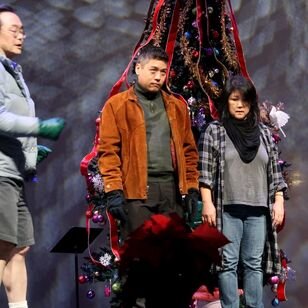Loryce Hashimoto: The Soul of an Artist
By Gwen Muranaka
Loryce Hashimoto is bubbly and enthusiastic, with an insatiable curiosity to try new things
It seems she is often there, at a concert, a recital, Day of Remembrance, a play, utilizing her many artistic talents, whether dancing or playing the shamisen, or doing comedy — there’s Hashimoto giving it her all and putting on a show.
“She is one of the most creative people I know, music and dance and crafting and writing and acting. She does all of that,” Randi Tahara said with amazement.
“Loryce is very generous in her time and her advice in her caring for people,” Tahara said. “I think that comes from her mother, Lily and father, Bill. They were both the best.”
Mickey Mouse floral tribute created by Loryce
The daughter of Bill and Lily Hashimoto, Hashimoto grew up around the beautiful blossoms of her parents’ florist shop, Lily’s Flowers and Gifts in Torrance. Eventually, she took over the business, running the shop until her retirement in 2015.
“Mom always wanted to do flowers. After the internment, dad married her and took her to Salt Lake City. There she worked in a Japanese-owned flower shop,” she explained.
Loryce at 6 yrs old - In her white and red yukata (Teacher: Chitose Sensei)
With mom’s encouragement, Hashimoto started to take classical Japanese dance with Chitose Kyokumoyu when she was five years old.
Tahara, who is Chitose’s granddaughter, recalled the girls practicing and performing together. On weekends, they would perform at Buddhist church picnics and community events.
When Chitose retired, Hashimoto would begin dance studies under Bando Mitsuhiro (Kiyoko Taniguchi) at age nine. Bando was born in Yatahama City, Ehime Prefecture, and studied under the legendary Bando Mitsugoro VIII. She taught dance in Japan for 20 years before deciding to move to the U.S. to continue her practice.
Learning under Bando Mitsuhiro was initially a culture shock. Hashimoto recalled struggling with the language. Being Japanese American and exuberant, she had to adopt to the “chanto” (precise) discipline of Japanese arts. Despite that, she excelled.
As a dancer with Bando Mitsuhiro Kai, she performed at various cities and sites such as Disneyland, Torrance Bunka Sai Japanese Cultural Festival and Japan America Theatre.
Natori Certification, Buyo 1978: Konko Church Los Angeles - Loryce, Bando Mitsugoro IX (Iemoto), and Bando Mitsuhiro
In the Japanese arts, students train for years to attain levels of mastery. In classical Japanese dance, a Natori signifies the dancer has mastered several dances to the satisfaction of the school’s headmaster. At 17 years old, Hashimoto was awarded her Natori certificate, but she retired from dance before attaining the level of Shihan -- accredited master teacher.
“Bando Oshisho asked me at age 21 if I wanted to become a Shihan but I turned it down,” Hashimoto said. “For me, once you decide to do that, your life is devoted to the art.”
Rehearsal Studio - Minyo Station
Dance remains her first love. When Bando Mitsuhiro passed away in August 2016, her dancers formed a new organization, Nihon Buyo Kai of California, devoted to the preservation of Japanese classical arts in America. Hashimoto serves on the group’s executive board, along with Tahara.
“Nihon Buyo Kai is an organization where we try to promote the arts, whether it’s odori, shaminsen, minyo,” Loryce said.
The organization also brings together the dance groups, who through the years knew one another but would not perform together.
“When a lot of the teachers were around, you would never see the other groups put on a show and ask another group to perform. There’s pride in there,” she explained.
“Nihon Buyo Kai put on a show that had dancers from Azuma, Nakamura and Bando.”
Another thread in Hashimoto’s artistic life is the shamisen, the three-stringed Japanese instrument played by strumming with a bachi.
Nisei Week closing
“In my soul I’m a dancer, but there’s different times in my life. Right now I’m shamisen,” she said.
“My strong point is the shamisen.”
Hashimoto first started studying nagauta shamisen with Kineya Kichisaburo. She continued until age 22, joined by Tahara and her cousin Bernice Hashimoto.
Tahara recalled performing together, including a memorable recital at Koyasan Buddhist Temple, when another girl hit a wrong note and they couldn't stop a fit of giggles and laughter.
“We couldn’t stop laughing. Teacher was sitting in back us and he started hitting our obis, saying ‘Hora! Hora! Hora!’” Tahara recalled with a smile. “Dancers stopped dancing, because we stopped singing.”
Hashimoto began taking minyo with Matsutoyo Sato, leader of Matsutoyo Kai, when she was in her late 20s, but decided to stop.
She said, “You’re good. If you really practice hard we can take you to Japan.” But I said, “Wait a minute.” I took a leave from Okeiko and finally returned after 20 years, Hashimoto said. “I didn’t want the expectations of being really good. I just wanted to play the shamisen.”
The reason she resumed the shamisen is another thread in her artistic career: the Grateful Crane Ensemble. The theater company has been entertaining Japanese and Japanese American audiences since 2001.
Minyo Natori Shamisen performance - James Armstrong 2014/15 with Sato Matsutoyo
Grateful Crane Producer Soji Kashiwagi said Hashimoto joined the group in 2006, playing a part in “Nihonmachi: the Place to Be.” The musical is a multigenerational tale of a Japanese American family that makes manju in a shop in Japantown.
“Because of her background in different Japanese cultural arts, we took advantage of her ability to play the shamisen,” Kashiwagi explained. “She plays shamisen to provide music to fit the period of prewar Japantown.”
Nisei Week Closing 2019 - Minyo Station
When she found out she would be playing the shamisen, Hashimoto turned to her old teacher.
Tanabata Festival 2019 - Dane Matsumura and Loryce
“I went to Matsutoyo Sensei and said ‘I need to learn this.’ I realized right then and there, it’s one thing to play it, but it’s something else to not fake it and really learn it,” Loryce said. “Because of that, I’m stuck.”
Since then, Hashimoto has been training in minyo with Matsutoyo Sato, learning the disciplines of shamisen as well as folk singing. She received her Natori title in 2014.
Marissa Kosugi of Matsutoyo Kai said that Hashimoto is a mentor and her “ane” -- big sister. They met through dancing together with Bando Mitsuhiro Kai.
“She’s always been a great mentor who understands the unspoken words in the Japanese cultural arts world: the etiquette, the passion, the dedication and loyalty,” Kosugi said. “She is a true artist who is not afraid of new projects that require a creative mind and the ability to express openly. I believe this is why she is able to accomplish many goals she sets for herself. Through her efforts, she has inspired many and her leadership is natural.”
In 2019, she traveled with Matsutoyo Kai to perform in a recital in Osaka with Naruse Shohei, a popular enka singer. In that instance, Matsutoyo asked Loryce to dance.
“As a joke I said, ‘I’ll dance for you,’” she said. “And she said, ‘OK.’ I spent two weeks in Japan for the Yamatogaku and Naruse Sensei's shows. And with teachers you don't joke around with.”
Yamatogaku in Tokyo 2019
During the trip they also took to the stage at the Japan National Theater in Chofu performing Yamatogaku, a style of singing that incorporates Western techniques including harmony, singing in round and humming.
One word to describe Hashimoto would be versatility.
Grateful Crane - J-Town Jazz Club with Kurt Kuniyoshi, Loryce, and Leslie Jones
For Grateful Crane, Kashiwagi recalled Hashimoto played a Nisei woman in the middle of a mental breakdown in “J-Town Jazz Club.” For “Natsukashi no Kohaku Uta Gassen,” Loryce played a comic role.
“She played this wacky JA Sansei cheerleader, who was out in the audience with a white fan and red fan, cheering on both sides,” Kashiwagi said.
“Loryce has played a variety of different roles over the years. And it’s all based on who she is and her versatility to do different things, either comedy or straight performance, she does shamisen and also has a Natori in dance,” he said.
A lLttle Tokyo Christmas - JAT 2018 - Ping Wu, Aaron Aoki, and Loryce
Writing is another passion of Hashimoto. She has taken classes with Tim Toyama on playwriting at Gardena Valley Japanese Cultural Institute and workshops with Jason Fong and has written four plays and given readings at the Rosenthal Theater at Inner City Arts.
In addition, she serves on the Day of Remembrance committee at the GVJCI, a program that marks the signing of Executive Order 9066.
For someone who has done so much, there was a dream that she hadn’t tried yet. She recalled a conversation she had with her husband, Dan Muramoto.
“Dan and I had a conversation; he asked: ‘What is your wildest dream if you had no barriers?’”
“I said, I want to do voiceovers, I want to do cartoon voiceovers. He gave me a phone number,” she said.
Loryce and Dan (Muramoto)
He told her: “If you want to do voice over, this is your dream, you call.”
She did. Unlike Japanese classical arts, something her mother pushed her to do, voiceover acting was her own dream.
She trained in voiceover, going to Hollywood, learning from various teachers, privately from Joan Gerber. Once a week she would relearn how to enunciate and also how to be loud.
“When you’re doing voiceover, you have to be crisp and precise.
All the teachers were saying "Loryce, that's good. Just need you to be louder. More animated"
“This is where (the Japanese) culture comes in, I would be in the booth and do characters. In my mind I’m screaming, but for them I’m (not loud enough),” she said.
In past years her voice was heard as the announcer for the Nisei Week Coronation.















